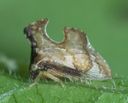Keeled Treehopper
Entylia carinata
Classification
- Phylum: Arthropoda
- Subphylum: Hexapoda
- Class: Insecta
- Order: Hemiptera
- Suborder: Auchenorrhyncha
- Infraorder: Cicadomorpha
- Superfamily: Membracoidea
- Family: Membracidae
- Subfamily: Smiliinae
- Tribe: Polyglyptini
- Genus: Entylia
- Species: carinata
Pronunciation
How to pronounce Entylia carinata: /ɛnˈtaɪliə ˌkærɪˈneɪtə/
These audio files are automatically generated. While they are not always 100% accurate, they are a good starting point.
Images






Summary
Entylia carinata, commonly known as the keeled treehopper, is a small treehopper species characterized by its distinctive saddle-shaped keels. They are often found on a variety of herbaceous plants and exhibit mutualism with ant species, which protect them in exchange for honeydew.
Physical Characteristics
Keeled treehoppers have unique saddle shaped keels, small and brown, with females averaging 6.35 mm long and males being slightly smaller with less noticeable keels.
Identification Tips
Males can sometimes be misidentified due to their variation in appearance compared to females.
Habitat
Leaf litter and debris during winter; found on a variety of herbaceous plants, especially within the Asteraceae family.
Distribution
Canada, eastern United States, Mexico, Central America, South America.
Diet
Phloem feeders; diet consists mainly of plant sap from various herbaceous plants, particularly Asteraceae.
Life Cycle
Adults spend the winter months in leaf litter and emerge in March. They reproduce by implanting their eggs on aster leaves, where they may cause the leaves to fold over to protect the nymphs.
Reproduction
Females lay eggs on aster foliage during vulnerable growth periods.
Ecosystem Role
Keeled treehoppers are phloem feeders and contribute to plant interactions, often involving ant mutualism.
Economic Impact
Not known to transmit plant diseases and not considered significant plant pests.
Similar Taxa
Misconceptions
Males can appear so different from females that they may be misidentified.
Tags
- Keeled Treehopper
- Entylia carinata
- Membracidae
- Hemiptera